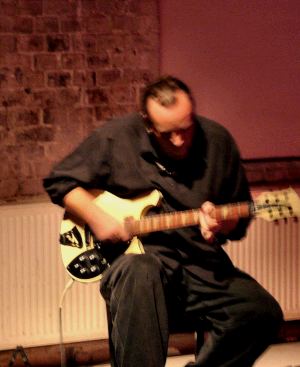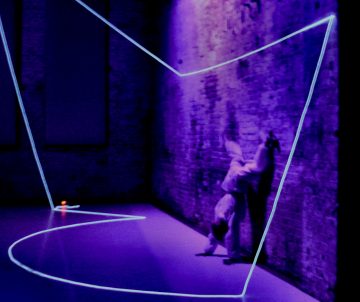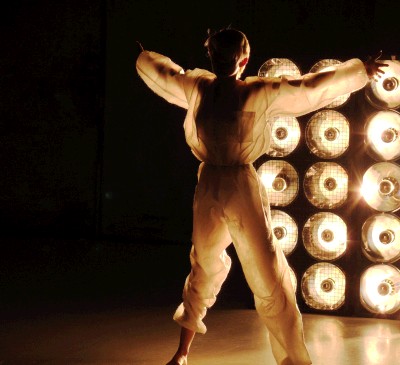Helga Wretman: Untitled
Dock11 in Berlin, August 2007
Helga Wretman: dance
Bertram Dhellemmes: music
Websites:
Helga Wretman
Bertram Dhellemmes
 The musician, alone on the stage, began the piece with a lengthy solo consisting mainly of dissonant and heavily echoed chords. The lack of recognizable structures in his music was a bit of a challenge to the audience. It reminded me of Pat Metheny's "White Noise", which annoyed all Metheny's fans who heard it, but it did not last that long. Hitting strings unavoidably generated rhythm, coming in and out of phase with the echo, and chords became less dense. After the dancer entered the stage, even sequences of discernible tones surfaced from the background. Few would enjoy this minimalism embedded in noise if presented for its own sake, but it suited well as an accompaniment to the dance. Dhellemmes wisely interlaced his music with long silent breaks.
The musician, alone on the stage, began the piece with a lengthy solo consisting mainly of dissonant and heavily echoed chords. The lack of recognizable structures in his music was a bit of a challenge to the audience. It reminded me of Pat Metheny's "White Noise", which annoyed all Metheny's fans who heard it, but it did not last that long. Hitting strings unavoidably generated rhythm, coming in and out of phase with the echo, and chords became less dense. After the dancer entered the stage, even sequences of discernible tones surfaced from the background. Few would enjoy this minimalism embedded in noise if presented for its own sake, but it suited well as an accompaniment to the dance. Dhellemmes wisely interlaced his music with long silent breaks.
Helga Wretman, wearing loose white trousers and wide open white blouse, entered the stage running circles round a dark construction standing in the middle, which later turned to be a set of twenty floodlights. Her choreography consisted of a solo danced on a dim stage, a series of static poses crafted against and on the wall, and a short finale in front of floodlights directed at the audience. Based upon what I learned after the performance, I recalled borrowing from pop culture at several places, but instead of following this line I will narrate a story which popped up in my mind at the beginning and got stronger with each scene. Imposing real-world stories upon modern dance is as futile as looking for them in instrumental music, but it is hard to get rid of an idea that offers a rationale for the vocabulary of a piece and accounts for its structure, too. The tale is entirely mine, Helga Wretman has not used associations with insects except for a spider in the neon triangle scene (part 2).
Part 1: Life of a larva
(Any flying insect suits the purpose: a dragonfly, wasp, butterfly...)
The sportive and pointedly cheerful opening scene is easily moved into a new context like this: a fly is encircling a place where it is going to rest and lay eggs. The first part of the piece exploits movements of a larva, hatched from one of these eggs. The larval body consists of a head and a lengthy trunk without extremities (entomologists forgive me) and it exhibits characteristic movement patterns. Attaching hands to the back of a head makes up a larval body, while waves traversing from legs via torso into the arms recall the most characteristic feature of a caterpillar. Another typical movement is opening and closing knees and elbows slowly in a coordinate fashion, which resembles breathing. (Dear entomologists, I know that this has nothing to do with insect breathing, but it looks like that!) The head falls far back and rolls to the side, as necks of larvae are much more flexible than human necks. There is a weird, jerky motif repeated in a deeply bent position several times: the repertoire of larvae is limited, but when they master a trick, they play it over and over.
At the end of her active live, the larva needs to build a cocoon. Wretman starts spinning around with her arms to shoulder height holding an imaginary thread (silk if she is a silk worm), wrapping it around her body. The spinning is fast and takes long, she nearly loses balance when it is done. This is how a larva might feel anyway after a cocoon is completed and all connections to the outside world are blocked.
Part 2: Metamorphosis
 The middle part is about the magic that happens in a cocoon when a heavy, fat larva is transformed into a feather-light adult insect (imago) with fragile wings and hair-thin legs. Neon light emanating from a triangle (see photo) was the only source illuminating the stage while the dancer was offering X-ray glances into this mysterious process. As there is no top or bottom in the cocoon and gravitation does not play any role, she often appeared with her head on the floor and legs up the wall. Metamorphosis proceeds slowly and no movement can be seen from outside as the body passes from one phase to the next. Under the sparse blue light, we guessed more than saw what was happening. Extremities appeared twisted and attached to where you wouldn’t expect them to be, legs grew above the dancer's head. At its own pace and in a complete silence, metamorphosis inexorably progressed towards its destiny.
The middle part is about the magic that happens in a cocoon when a heavy, fat larva is transformed into a feather-light adult insect (imago) with fragile wings and hair-thin legs. Neon light emanating from a triangle (see photo) was the only source illuminating the stage while the dancer was offering X-ray glances into this mysterious process. As there is no top or bottom in the cocoon and gravitation does not play any role, she often appeared with her head on the floor and legs up the wall. Metamorphosis proceeds slowly and no movement can be seen from outside as the body passes from one phase to the next. Under the sparse blue light, we guessed more than saw what was happening. Extremities appeared twisted and attached to where you wouldn’t expect them to be, legs grew above the dancer's head. At its own pace and in a complete silence, metamorphosis inexorably progressed towards its destiny.
Part 3: Witnessing the mystery
 The cocoon opens and an adult emerges under the sunlight. The purpose of the sole existence of the larva is fulfilled. The audience feels the majesty of the moment, covering their eyes blinded by the floodlight. The dancer assumes triumphal poses. She does not move much because a freshly hatched imago has to let her wings and body surface harden before she can take off. The scene is short, majestic moments don't last for long.
The cocoon opens and an adult emerges under the sunlight. The purpose of the sole existence of the larva is fulfilled. The audience feels the majesty of the moment, covering their eyes blinded by the floodlight. The dancer assumes triumphal poses. She does not move much because a freshly hatched imago has to let her wings and body surface harden before she can take off. The scene is short, majestic moments don't last for long.
For those who skipped the beginning, the story was made up by me. The choreograph neither intended nor endorsed it (though I hope she will not mind my meddling). Now let's put the story aside. I liked the way the sequence in the first part was arranged, in an order which appeared spontaneous but not random. The audience would enjoy this part even more if they could see it better, I mean if the light was brighter – at least towards the end. This would also provide a nice contrast to the subsequent scene performed in a dimmed light in the neon triangle. Other memorable aspects were the use of light to switch between unusual stage settings without breaks, and the way sound, silence and dance (rather than just sound and dance) were each given its own space and emphasis. All in all it was a witty, fresh and appetizing performance.
Petr Karlovsky